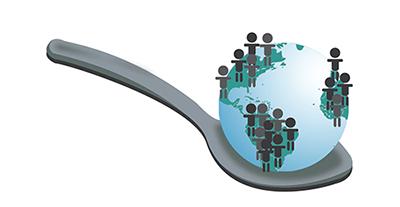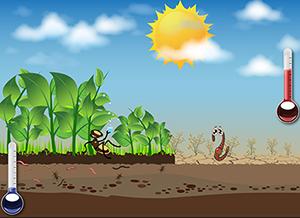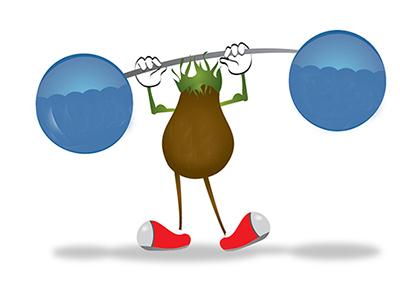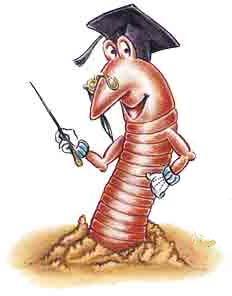Soil Health Quiz 1

10 fun and interesting true/false questions about healthy soil.
- 1.
Regular tillage/plowing helps keep open pores at the soil’s surface and increases water infiltration into the soil.
- A.
True
- B.
False
Correct Answer
B. FalseExplanation
False. You may be happily hoeing in your garden thinking you’re helping your plants receive the water they need, but hoeing (or tillage/plowing) actually reduces the capacity of the soil to receive and hold water. Tillage destroys soil aggregates and the biologically produced glues that hold soil aggregates together. This results in the collapse of those aggregates and the pores between them, which can lead to compaction and crusting. However, by using “no-till” drills and planters, farmers can insert the seed into the soil by cutting a very narrow slice into the soil—resulting in minimal soil disturbance.
Resource: Tisdall, et. al., “Organic matter and water-stable aggregates in soils,” Journal of Soil Science, 1982, 33, 141-163.Rate this question:
-
- 2.
Microorganisms in the soil generally harm plants.
- A.
True
- B.
False
Correct Answer
B. FalseExplanation
False. Most microorganisms are beneficial to plants in many ways. For example, they decompose residues, and so are able to build soil aggregates. They also make key nutrients available to plants, such as nitrogen, phosphorous, and potassium, through nutrient cycling that is the result of a dynamic soil food web involving soil microorganisms like bacteria, fungi, protozoa and nematodes. Beneficial organisms can also help fight disease organisms. Those tiny organisms are so important that many plants exude substances through their roots to attract them to live in their root zones.
Resources: Brady and Weil, “The Nature and Properties of Soils” 13th edition, pg. 709; Shen, et. al. “Phosphorus Dynamics: From Soil to Plant; Plant Physiology,” American Society of Plant Biologists, July 2011, Vol. 156, pp. 997–1005, 2011Rate this question:
-
- 3.
In a teaspoon or two of healthy soil there can be more living organisms than there are people on the globe.
- A.
True
- B.
False
Correct Answer
A. TrueExplanation
True. And those living organisms play a critical role in decomposing crop residue into soil organic matter that enhances nutrient cycling and a soil’s available water holding capacity.
Resources: Brady and Weil, “The Nature and Properties of Soils,” 13th edition, page 458; Colorado State University Extension CMG GardenNotes #212.Rate this question:
-
- 4.
Half of a healthy soil's composition should be pore space that contains air, water, and microorganisms.
- A.
True
- B.
False
Correct Answer
A. TrueExplanation
True. An ideal soil composition by volume should be about 50 percent solids (45 percent mineral and 5 percent organic matter, though this depends on climate and texture, too!), and approximately 50 percent pore space (in ideal weather approximately 25 percent air and organisms that need that air to breathe, 25 percent water).Rate this question:
-
- 5.
Organic matter buffers the soil against big changes in moisture and temperature.
- A.
True
- B.
False
Correct Answer
A. TrueExplanation
True. Organic matter provides insulation from variations in temperatures and it provides greater water holding capacity. Increasing the soil organic matter by one percent can add approximately one inch of water to the soil profile.
Resource: NCSU Soilfacts publication AWG-439Rate this question:
-
- 6.
Healthy soil should be allowed to rest from time to time – that is to lie bare without growing plants.
- A.
True
- B.
False
Correct Answer
B. FalseExplanation
False. Having plants growing all the time allows more solar energy to be converted into carbon to feed soil microbial populations and improve soil health. When living roots grow in the soil throughout the year, they continuously feed soil organisms and build porous soil structure (through root and earthworm channels, decomposing residues to create soil organic matter, and producing biotic glues). Root-fed microorganisms also help make nutrients available to crops.
Resource: Altieri, “The Ecological role of Biodiversity in agroecosystems,” 1999Rate this question:
-
- 7.
Fungi are not needed for healthy plant growth.
- A.
True
- B.
False
Correct Answer
B. FalseExplanation
False. Arbuscular mycorrhizal fungi (abundant in healthy soils) have a symbiotic relationship with almost all agricultural plants. They grow into the inside of plant roots to tap into the sugars and carbohydrates transported from the plant leaves. In turn, the fungal hyphae (filaments) that grow out from the roots bring water and soil nutrients back to the plant, and they can even help protect roots from pathogens. (A pretty amazing relationship, huh?)
Resource: Brundrett, et. al., “Working with Mychorrhizas in Forestry and Agriculture,” 1996.Rate this question:
-
- 8.
Each one percent increase in soil organic matter could increase soil water holding capacity by 20,000 - 25,000 gallons per acre.
- A.
True
- B.
False
Correct Answer
A. TrueExplanation
True. A one percent increase in soil organic matter could result in as much as 20,000 to 25,000 more gallons of available soil water per acre. (That's the amount of water that will fill a typical 18'x36' residential swimming pool.) And since only a portion of the total water in a soil is “available,” the increase in the soil’s water holding capacity is even greater than that. That’s the kind of water retention we can all live with!
Resource: Kansas State University e-Updates, Number 357, July 6, 2012. Note that amount of water stored in a specific soil will differ by soil texture and other factors.’
Resource: Kansas State University e-Updates, Number 357, July 6, 2012.Rate this question:
-
- 9.
Earthworms are more abundant in tilled or plowed soil.
- A.
True
- B.
False
Correct Answer
B. FalseExplanation
False. Tillage damages earthworms directly, and also damages the habitat earthworms need to survive. It stimulates drying the surface soil and creates wide day/night temperature fluctuations. Tillage also brings earthworms to the surface where they are subject to predators such as birds. Total earthworm populations in long-term no-tilled fields are typically at least twice those of clean-tilled fields.
Resources: Edwards and Bohlen, “Biology and Ecology of Earthworms,” 1996 (Chapman & Hall, London, UK) and “The farmer’s earthworm handbook,” Ernst, 1995 (Lessiter Publications, Inc., Brookfield, Wis.).Rate this question:
-
- 10.
Leonardo DiCaprio wrote, “We know more about the movement of celestial bodies than about the soil underfoot.”
- A.
True
- B.
False
Correct Answer
B. FalseExplanation
False. (Hey, we had to throw in one tricky question.) It was the other Leonardo – Leonardo da Vinci. And he’s probably right. Though we’re learning more about the soil’s complex and miraculous ecosystem every day – the more we discover, the more we realize how much more there is to still learn about that amazing universe beneath our feet.Rate this question:
-
Quiz Review Timeline +
Our quizzes are rigorously reviewed, monitored and continuously updated by our expert board to maintain accuracy, relevance, and timeliness.
-
Current Version
-
Oct 04, 2024Quiz Edited by
ProProfs Editorial Team -
Jun 22, 2015Quiz Created by
SoilGeek












